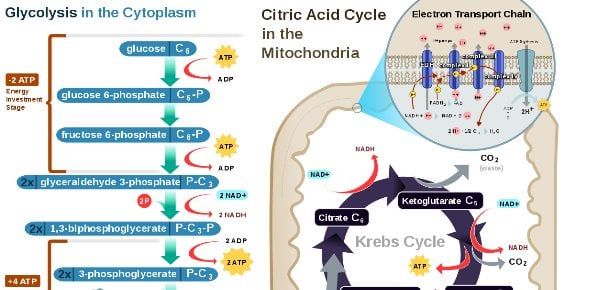Overview Of Cellular Respiration And Mitochondria Structure
-
What is glucose transformed in to in glycolysis?
-
Fructose
-
Carbon Dioxide
-
Water
-
Pyruvate
-

Explore the fundamentals of cellular respiration and mitochondria structure in this quiz. Assess your understanding of glycolysis, the Kreb's Cycle, and the electron transport chain. Learn about key components like ATP synthase and the role of mitochondria in energy production.
- 2.
How many steps are in glycolysis?
-
3
-
6
-
9
-
2 1/2
Correct Answer
A. 9Explanation
Glycolysis is the metabolic pathway that converts glucose into pyruvate, producing ATP and NADH in the process. It consists of 10 steps, with the first five steps requiring energy input (investment phase) and the remaining five steps producing ATP and NADH (payoff phase). Therefore, the correct answer is 9, as there are 9 steps in the glycolysis pathway.Rate this question:
-
- 3.
Where do Glycolosis, Kreb’s Cycle, and Electron Transport occur respectivly?
-
Matrix, Inner membrane, cytosol
-
Cytosol, Matrix, Between inner and outer membrane
-
Inner membrane, Matrix, Inner membrane space
-
Golgi Apparatus, ER, Mitochondria
Correct Answer
A. Cytosol, Matrix, Between inner and outer membraneExplanation
Glycolysis occurs in the cytosol, the fluid portion of the cytoplasm outside the organelles. The Kreb's Cycle, also known as the citric acid cycle, takes place in the matrix of the mitochondria, which is the innermost compartment of the mitochondria. The Electron Transport Chain occurs between the inner and outer membrane of the mitochondria, specifically in the inner membrane space. This is where the transfer of electrons from electron carriers occurs, generating ATP.Rate this question:
-
- 4.
What are the first two molecules that start the Kreb’s cycle?
-
ATP and H2O
-
Pyruvate and Citrate
-
Acetyl CoA and pyruvate
-
Acetyl CoA and Oxaloacetate
Correct Answer
A. Acetyl CoA and OxaloacetateExplanation
The Kreb's cycle, also known as the citric acid cycle, is a series of chemical reactions that occur in the mitochondria of cells. It is an important part of cellular respiration, where glucose is broken down to produce energy in the form of ATP. Acetyl CoA and oxaloacetate are the first two molecules that start the Kreb's cycle. Acetyl CoA is formed from the breakdown of glucose or fatty acids, and it combines with oxaloacetate to form citrate, which is the first intermediate in the cycle. Therefore, the correct answer is Acetyl CoA and Oxaloacetate.Rate this question:
-
- 5.
What are the cristae?
-
The folds in the outer membrane
-
The material inside the inner membrane
-
The folds in the inner membrane
-
The area between the inner and outer membranes
Correct Answer
A. The folds in the inner membraneExplanation
The cristae are the folds in the inner membrane of mitochondria. These folds increase the surface area of the inner membrane, allowing for more space for cellular respiration and the production of ATP. The cristae also contain the enzymes and proteins necessary for these processes.Rate this question:
-
- 6.
What is the spinning turbine that create ATP in the electron transport chain called?
-
The ATP synthase
-
A protein channel
-
An electron carrier
-
Phosphorylation channel
Correct Answer
A. The ATP synthaseExplanation
The spinning turbine that creates ATP in the electron transport chain is called the ATP synthase. It is responsible for the synthesis of ATP by utilizing the energy generated from the flow of protons across the inner mitochondrial membrane. This enzyme acts as a molecular motor, converting the potential energy of the proton gradient into the chemical energy stored in ATP molecules.Rate this question:
-
Quiz Review Timeline (Updated): Mar 22, 2023 +
Our quizzes are rigorously reviewed, monitored and continuously updated by our expert board to maintain accuracy, relevance, and timeliness.
-
Current Version
-
Mar 22, 2023Quiz Edited by
ProProfs Editorial Team -
Dec 07, 2009Quiz Created by
Bach.jono
 Back to top
Back to top


